1996 MITSUBISHI PAJERO brake
[x] Cancel search: brakePage 110 of 302
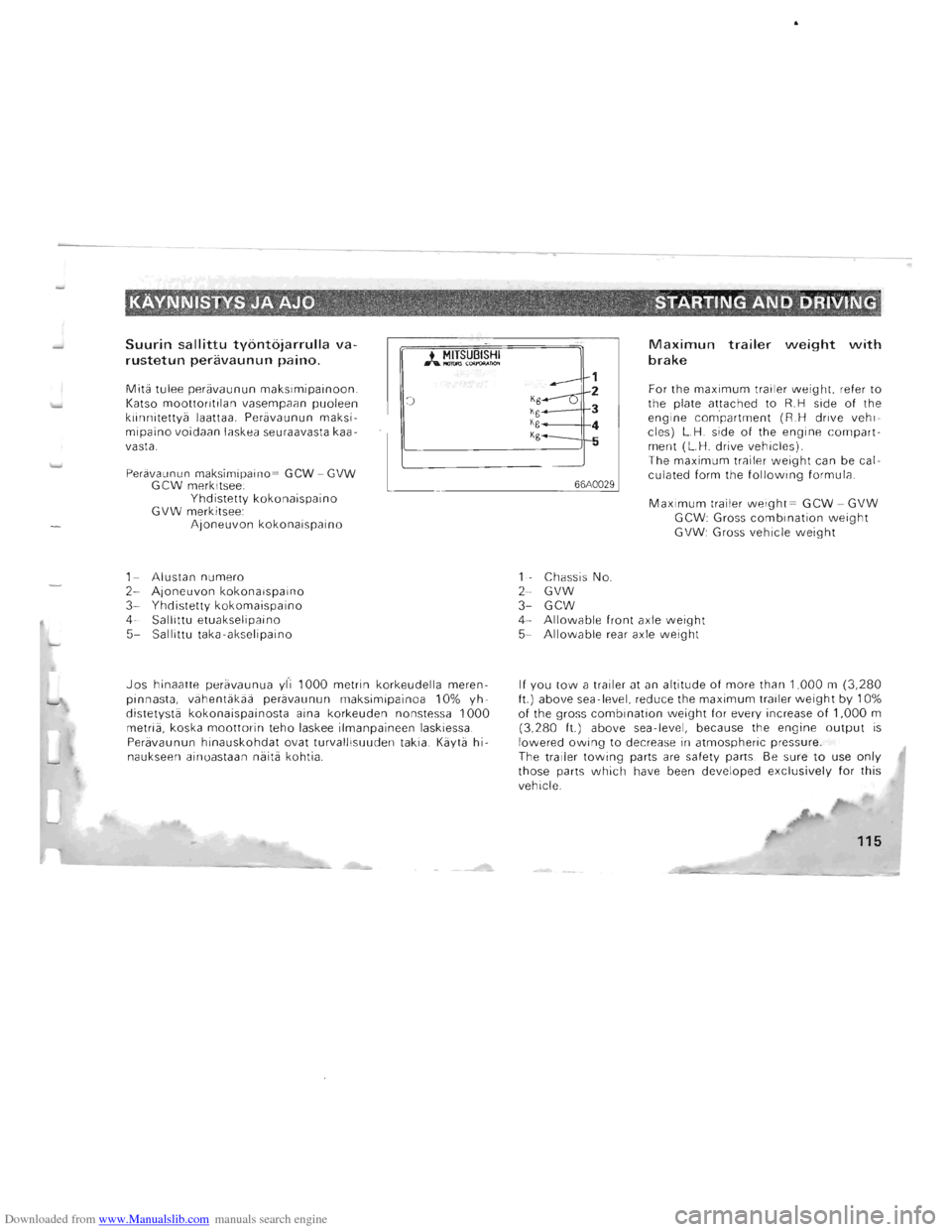
Downloaded from www.Manualslib.com manuals search engine '"-----------~~
KAYNNISTVS JA,AJO " ' :" ,,' , ':,',' .,,', I, , ' • ,STARTING ANO DRIVING' , -",'_"..:"'-~'., ~'. ¥ •• , '," ~ :.1,",-~, "',; ";~" .'" ,..... q ~'l, • ,
Suurin sallittu tyontojarrulla va
rustetun peravaunun paino,
Mita tulee peravaunun maksimipainoon,
Katso moottoritilan vasempaan puoleen kiinnitettya laattaa , Peravaunun maksimipaino voidaan laskea seuraavasta kaa
vasta,
Periivaunun maksimipaino = GCW -GVW
GCW merkitsee: Yhdistetty kokonaispaino GVW merkitsee: Ajoneuvon kokonaispaino
1-Alustan numero 2-Ajoneuvon kokonaispaino 3 -Yhdistetty kokomaispaino 4 -Sallittu etuakselipaino 5-Sallittu taka-akselipaino
_ ..
~!!!lS~)j!
0
Jos hinaatte peravaunua yli 1000 metrin korkeudella meren
pinnasta , vahentakaa peravaunun maksimipainoa 10% yhdistetysta kokonaispainosta aina korkeuden nonstessa 1000 metria, koska moottorin teho laskee ilmanpaineen laskiessa.
Peravaunun hinauskohdat ovat turvallisuuden takia. Kayta hi
naukseen ainoastaan naita kohtia.
..
--
1
Ks----z5 1--2
3 Kg Kg 4 Kg_ f--5
66AOO29
1- Chassis No. 2-GVW 3 -GCW
Maximun trailer weight with
brake
For the maximum trailer weight refer to the plate attached to R.H side of the
e ngine com'partment (R.H drive vehicles) L.H. side of the engine compartment (L,H. drive vehicles) .
The maximum trailer weight can be cal
culated form the following formula .
Maximum trailer weight= GCW -GVW GCW: Gross combination weight
GVW: Gross vehicle weight
4-Allowable front axle weight 5-Allowable rear axle weight
If you tow a trailer at an altitude of more than 1,000 m (3,280 ft,) above sea-level, reduce the maximum trailer weight by 10% of the gross combination weight for every increase of 1,000 m (3,280 ft.) above sea-level, because the engine output is lowered owing to decrease in atmospheric pressure.
The trailer towing parts are safety parts. Be sure to use only
those parts which have been developed exclusively for this
vehicle .
Page 111 of 302

Downloaded from www.Manualslib.com manuals search engine KAYNNISTYS JA AJO . STARTING AND DRIVING
Suurin sallittu vetokoukun palloniveleen kohdistuva
kuormitus
Alkaa koskaan ylittakb Teknillisissa tiedoissa ilmoitettua sail it
tua kuormitusta. (Katsokaa sivua 115.)
Kayttovihjeita
(1) Alkaa antako kytkimen luistaa (ajoneuvoissa joissa on
kasivaihteisto ainoastaan). alk aaka lisatkb kayn-nistaessanne tarpeettomasti moottorin nopeutta. (2) Alkaa ylittakb nopeutta, joka on suosite ltu peravaunua
hinattaessa .
(3) Valttaaksenne tybntbjarrusta johtuvia tbytaisyja painakaa jarrupoljinta ensin kevyesti ja sitten voimakkaammin. (4) Saadaksenne tayden hybdyn moottorijarrusta vaihtakaa
pienemmalle ennen alamakea . (5) Peravaunun hinaaminen tuottaa lisarasitusta rungolle, jarruille, kytkimelle ja alustalle. (6) Peravaunun paino ja suurempi kitka ja ilmanvastus lisaavat polttoaineenku lutusta.
lisavarotoimenpiteita ajoneuvoille joissa on auto
maattinen vaihteisto
Asentoa "2" suositellaan kaytettavaksi rinteissa tai alhal-sella nopeudella ajettaessa. Kayttakaa asentoa "L" vuoristoteilla,
koska silloin moottorijarru toimii parhaiten edesauttaen nain
jarrujarjestelmaa. Varmistakaa kuitenkin etta nopeus ei ylita valitulle vaihteelle asetettua nopeusrajoiutsta.
Mita tulee maksiminopeuteen, katso kohtaa "Mahdollinen ajonopeU(>" sivulta 131.
116
Maximum trailer-nose weight
Never exceed the maximun trailer-nose weight as listed in the specifications. (Refer to page 115.)
Operating hints
(1) Do not let the clutch slip (vehicles with a manual transmission only) and do not increase the engine speed more than necessary when starting. (2) Be sure that the driving speed does not exceed the maximum speed for trailer operation. (3) To prevent shocks from the overrun brake, depress the brake pedal lightly at first and then more strongly. (4) To make full use of engine braking, change to a lower gear
before descending a slope . (5) The body, brakes, clutch, and chassis will be under addi tional strain when towing a trailer . (6) The heavier weight and the higher rolling and air resistance
w ill increase fuel consumption.
Additional precautions for vehicles equipped with
an automatic transmission
It is recommended the "2" position on slopes or at low speed.
Us e the "L " position in mountainous areas in order to make
better use of engine braking and to assist the brake system. However, be sure that the speed does not exceed the maximum speed limit for the selected gear.
For
maximum speed, refer to the description of the "Possible driving speed" on page 131.
Page 113 of 302
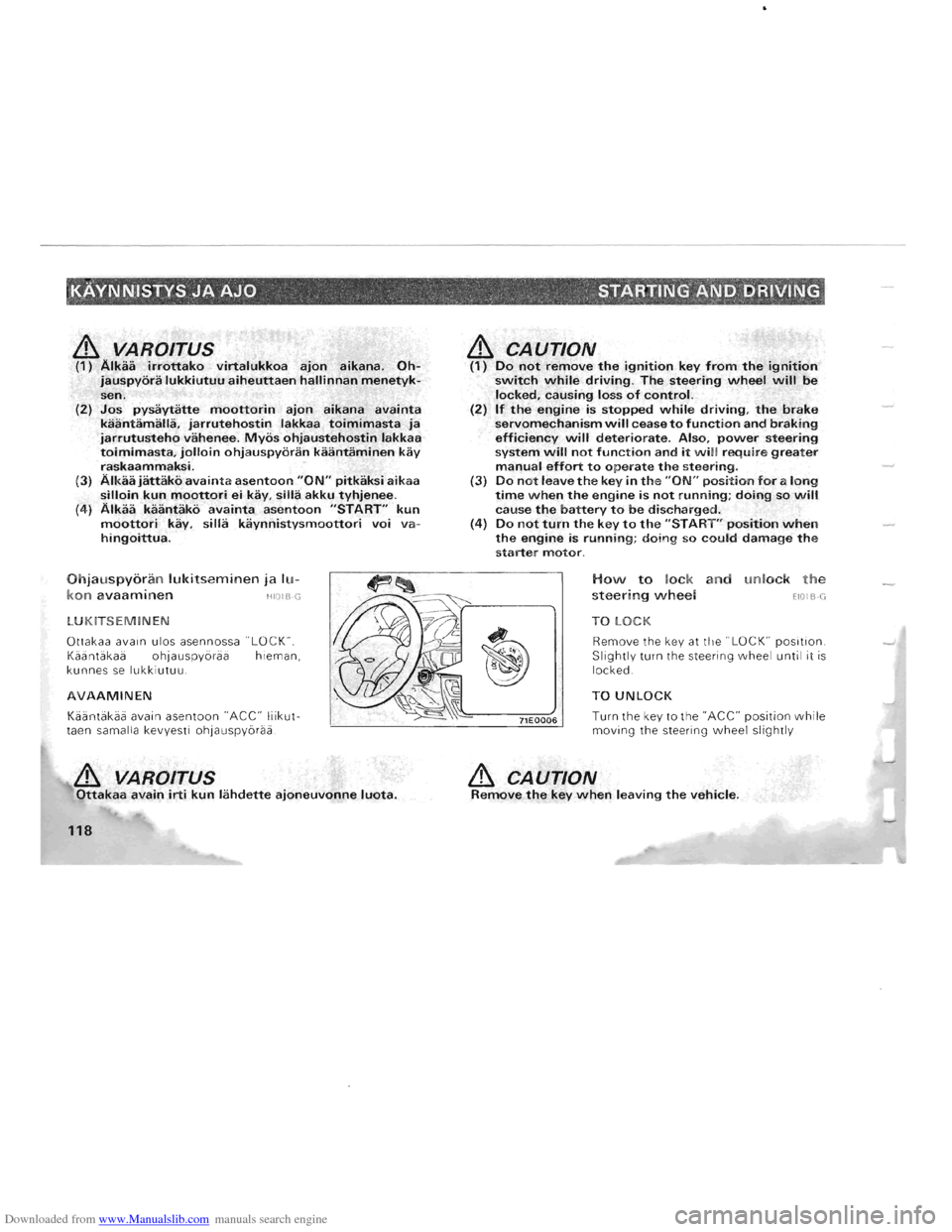
Downloaded from www.Manualslib.com manuals search engine KAvNN.ISTYS JA AJO . . . STARTING ' ANO'oDRIVING ., . .. . .. ~, ' . ',-.'. ' '
& VAROITUS (1) Alkaa irrottako virtalukkoa ajon aikana, Ohjauspyora lukkiutuu aiheuttaen hallinnan menetyksen. (2) Jos pysaytatte moottorin ajon aikana avainta kaantamalla. jarrutehostin lakkaa toimimasta ja jarrutusteho vahenee. Myos ohjaustehostin lakkaa toimimasta. jolloin ohjauspyoran kaantaminen kay raskaammaksi. (3) Alkaa jattako avainta asentoon "ON" pitkaksi aikaa silloin kun moottori ei kay, silla akku tyhjenee. (4) Alkaa kaantako avainta asentoon "START" kun moottori kay, silla kaynnistysmoottori voi vahingoittua.
Ohjauspyoran lukitseminen ja lu
kon avaaminen HIOIB·G
LUKITSEMINEN
Ottakaa avain ulos asennossa "LOCK".
Kiiiintiikiiii ohjauspybriiii hieman , kunnes se lukkiutuu.
AVAAMINEN
Kiiiintiikiiii avain asentoon "Ace liikut
taen samalla kevyesti ohjauspybriiii.
& VAROITUS Ottakaa avain irti kun lahdette ajoneuvonne luota.
118
& CAUTION (1) Do not remove the ignition key from the ignition switch while driving. The steering wheel will be locked, causing loss of control. (2) If the engine is stopped while driving, the brake servomechanism will cease to function and braking efficiency will deteriorate. Also, power steering system will not function and it will require greater manual effort to operate the steering. (3) Do not leave the key in the "ON" position for a long time when the engine is not running; doing so will cause the battery to be discharged. (4) Do not turn the key to the "START" position when the engine is running; doing so could damage the starter motor.
71E0006
How to lock and unlock the
steering wheel EIOIB· G
TO LOCK
Remove the key at the "LOCK" position. Slightly turn the steering wheel until it is
locked.
TO UNLOCK
Turn the key to the "ACe position while moving the steering wheel slightly.
& CAUTION Remove the key when leaving the vehicle.
Page 115 of 302

Downloaded from www.Manualslib.com manuals search engine KAVNNISTYS JA AJO.'· . STARTING AND DRIVING
Bensiinikayttoi-set ajoneyvot
Tama auto on varustettu elektronisesti ohjatulla suihkutusjar
jestelmalla, joka saatelee automaattisesti polttoaineen maaran.
Kaynnistaessasi
moottoria ala paina kaasupoljinta.
1 . Veda kasijarru paalle.
2 . Kasivalitteisella vainteistolla varustetussa autossa siirretaan
vainde "
N" asentoon (vapaalle) ja kytkin painetaan poh
jaan . Automaattivaihteisessa autossa sarretaan vaihteenva
litsin
"P" asentoon .
3 . Kaynnista moottori painamatta kaasupoljinta .
HUOM Mikali moottori on saanut liikaa polttoainetta, pyorita moottoria 5 -6 sekuntia kaasupoljin pohjaan painettuna. Kaynnista moottori taman
jalkeen koskematta kaasupolkimeen.
Erittain kylmassa ympariston lampotilassa
Jos moottori ei tahdo kaynnistya, painakaa kaasutinpoljinta
noin puolivaliin saakka samalla kun yritatte kaynnistaa moottoria. Heti kun moottori kaynnistyy, vapauttakaa kaasutinpoljin.
120
Petrol-powered vehicles
This vehicle is equipped with an electronically controlled
injection device and fuel injection amount is automatically controlled. When starting the engine, do ot depress the accel
erator pedal.
1 .
Apply the parking brake.
2 . On vehicles with a manual transmission , move the gearshift lever to the "N" position (Neutral) and depress the clutch pedal all the way. On vehicles with an automatic transmis
sion, move the selector lever to the "P" position. 3 . Start the engine without depressing the accelerator pedal.
NOTE
If the engine has become flooded during starting , first operate
the starter for 5 or 6 seconds while depressing the accelerator
pedal fully, and then start the engine without depressing the
accelerator pedal.
At extreme cold ambient temperature
If the engine won't start, depress the accelerator pedal about halfway during cranking the engine. Once the engine starts,
release the accelerator pedal.
Page 116 of 302

Downloaded from www.Manualslib.com manuals search engine -
KAVNNISTYS JA AJO· . STARTING AND DRIVING·
Dieselkayttoiset ajoneuvot HI02S·K
Ajoneuvot. joissa el ole dieselin esilammityksen
merkkivaloa
1. Pankaa pysakbintijarru paalle.
2 . Ajoneuvoissa joissa on kasivaihteisto , siirretaan vaihdevipu
vapaalle ja painetaan
kytkin aivan pohjaan. Ajoneuvoissa
joissa on automaattivaihtesto, slirretaan valitsinvipu "P"asentoon. 3. Kayttakaa kaasupoljinta seuraavasti:
(1) Kin ilman lampbtila on normaali tai moottori lammin kayn
nistakaa
moottori painamatta kaasupoljinta. (2) Kun ilman lampbtila on matala ja moottori on kylma
kaynnistakaa moottori samalla painaen kaasupoljinta . 11-man lampbtilan ollessa hyvin matala kaynnistyy moottori helpommin jos virta-avaimen kaantaa "ON" asentoon
muutamaksi sekunniksi ennenkuin moottori kaynnistetaan.
Ajoneuvot. joissa on dieselin esilammityksen merk
kivalo
1. Pankaa pysakbintijarru paalle. 2. Ajoneuvoissa joissa on kasivaihteisto, siirretaan vaihdevipu
vapaalle ja painetaan kytkin aivan pohjaan . Ajoneuvoissa
joissa on automaattivhteisto, slirr etaan valitsinvipu "P"asentoon.
3 . Kaantakaa virta-avain ON asentoon . Dieselin esilam
mityksen merkkivalo palaa ensin punaisena ,
muuttuen het
ken kuluttui vihreaksi merkiksi siita, etta esilammitys on
suoritettu.
Diesel-powered vehicles EI02S·K
Vehicles not equipped with diesel preheat indica
tion lamp
1 . Apply the parking brake.
2. On vehicles with a manual transmission , move the gearshift
lever to neutral and depress the clutch pedal all the way. On
vehicles with an automatic transmi ssion, move the selector
lever to the" P" position . 3. Operate the accelerator pedal as described below in accor
dance with the atmospheric temperature and/or engine condition and then start the engine .
(1) When the atmospheric temperature is moderate or the
engine is warm , start the engine without depressing the
accelerator pedal.
(2) When the atmospheric temperature is low and the engine is cold, start the engine while depressing the accelerator
pedal. If the atmospheric temperature is very low, setting
the ignition switch to ON for one or two seconds before attempting to start the engine will make it easier to start
Vehicles equipped with the diesel preheat indication
lamp
1. Apply the parking brake. 2. On vehicles with a manual transmission , move the gearshift
lever to neutral and depress the clutch pedal all the way. On
vehicles with an automatic transmission , move the selector
lever to the" P" position .
3. Turn the ignition key to the "ON" position. The diesel
preheat indication lamp will first illuminate in red , and then
after a short time change
to green, indicating that preheat
ing is completed.
121
Page 126 of 302
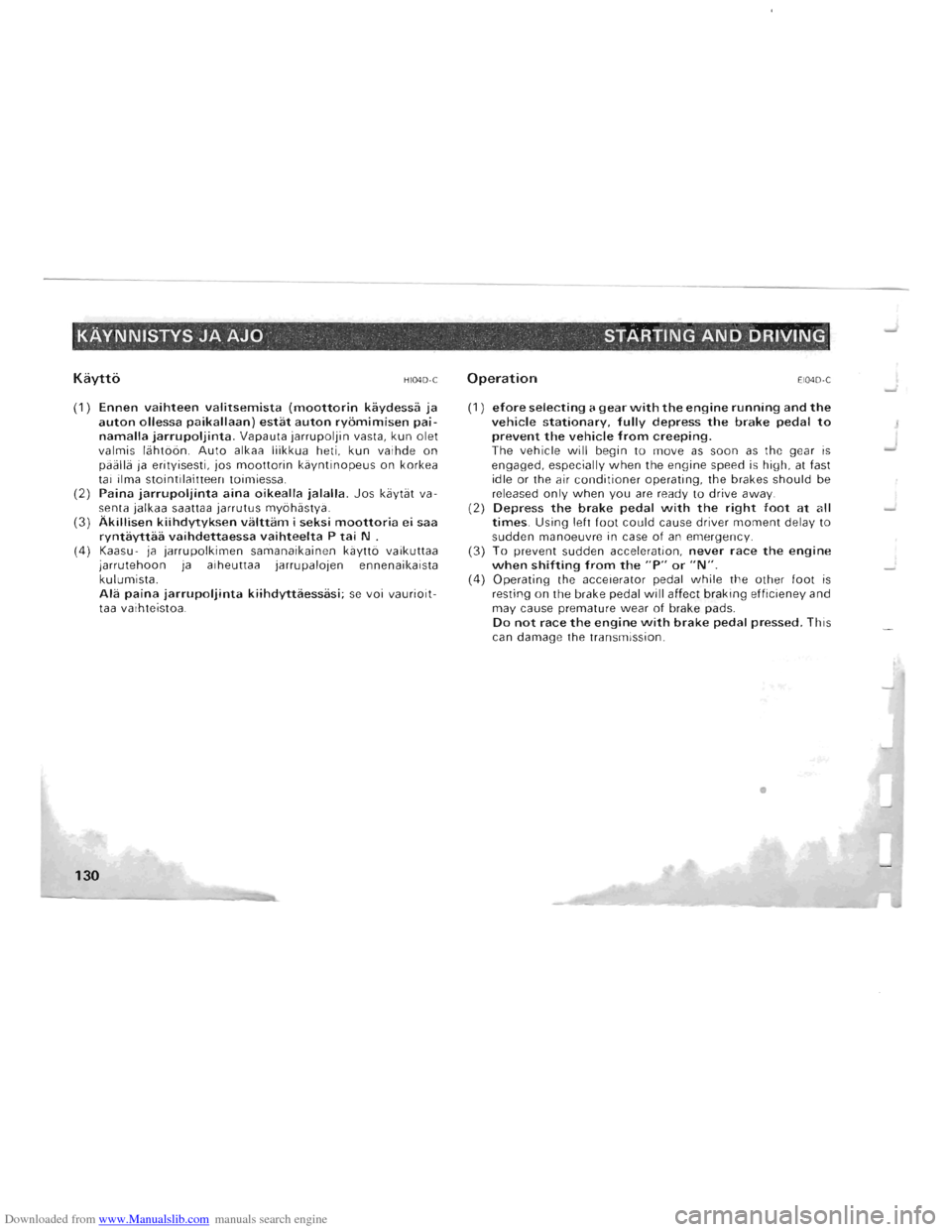
Downloaded from www.Manualslib.com manuals search engine KAVNNISTYS JA AJO STARTING AND DRIVING
Kaytto HI04D-C
(1) Ennen vaihteen valitsemista (moottorin kaydessa ja auton ollessa paikallaan) estat auton ryomimisen painamalla jarrupoljinta. Vapauta jarrupoljin vasta, kun olet valmis lahtoon. Auto alkaa liikkua heti, kun vaihde on paalla ja erityisesti , jos moottorin kayntinopeus on korkea
tai ilma stointilaitteen toimiessa . (2) Paina jarrupoljinta aina oikealla jalalla. Jos kay tat va
senta jalkaa saattaa jarrutus myohastya .
(3) Akillisen kiihdytyksen valttam i seksi moottoria ei saa ryntayttaa vaihdettaessa vaihteelta P tai N . (4) Kaasu- ja jarrupolkimen samanaikainen kaytto vaikuttaa jarrutehoon ja aiheuttaa jarrupalojen ennenaikaista
kulumista.
130
Ala paina jarrupoljinta kiihdyttaessasi; se voi vaurioit
taa vaihteistoa .
Operation EI04D-C
(1) efore selecting a gear with the engine running and the
vehicle stationary, fully depress the brake pedal to prevent the vehicle from creeping. The vehicle will begin to move as soon as the gear is
engaged , especially when the engine speed is high , at fast
idle or the air conditioner operating, the brakes should be
releas ed only when you are ready to drive away. (2) Depress the brake pedal with the right foot at all times. Using left foot could cause driver moment delay to sudden manoeuvre in case of an emergency. (3) To prevent sudden acceleration , never race the engine when shifting from the "P" or "N". (4) Operating the acceierator pedal while the other foot is
resting on the brake pedal will affect braking efficieney and
may cause premature wear of brake pads. Do not race the engine with brake pedal pressed . This
can damage the transmission .
•
I -
Page 128 of 302
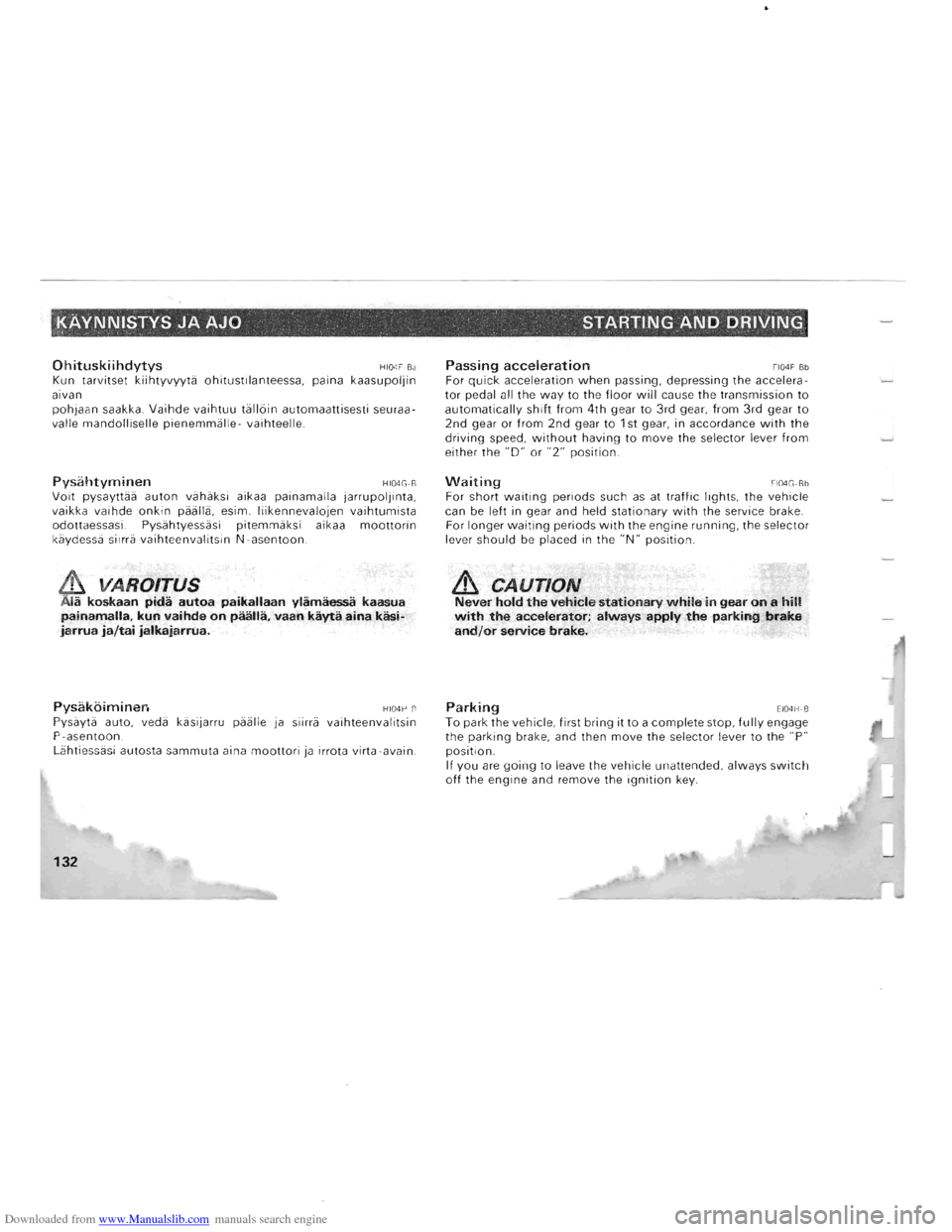
Downloaded from www.Manualslib.com manuals search engine KAVNNISTYS JA AJO STARTING AND DRIVING , . -~
Ohituskiihdytys HI04F·Ba Kun tarvitset kiihtyvyyta ohitustilanteessa, paina kaasupoljin aivan pohjaan saakka. Vaihde vaihtuu tallbin automaattisesti seuraa
valle mandolliselle pienemmalle- vaihteelle.
Pysahtyminen HI04G ·B Voit pysayttaa auton vahaksi aikaa painamalla jarrupoljinta, vaikka vaihde onkin paalla, esim. liikennevalojen vaihtumista odottaessasi. Pysahtyessasi pitemmaksi aikaa moottorin kaydessa siirra vaihteenvalitsin N-asentoon.
& VAROITUS Ala koskaan pida autoa paikallaan ylamaessa kaasua painamaJla. kun vaihde on paalla. vaan kayta aina kasijarrua ja/tai jalkajarrua.
Pysakoiminen HI04H·B Pysayta auto, veda kasijarru paalle ja siirra vaihteenvalitsin P-asentoon. Lahtiessasi autosta sammuta aina moottori ja irrota virta-avain.
132
Passing acceleration EI04F-Bb For quick acceleration when passing, depressing the accelerator pedal all the way to the floor will cause the transmission to automatically shift from 4th gear to 3rd gear, from 3rd gear to 2nd gear or from 2nd gear to 1 st gear, in accordance with the driving speed, without having to move the selector lever from either the "D" or "2" position.
Waiting EI04G-Bb For short waiting periods such as at traffic lights, the vehicle
can be left in gear and held stationary with the service brake.
For longer waiting periods with the engine running, the selector
lever should be placed in the "N" position.
& CAUTION Never hold the vehicle stationary while in gear on a hill with the accelerator; always apply the parking brake and/or service brake. .
Parking EI04H·B To park the vehicle, first bring it to a complete stop, fully engage the parking brake, and then move the selector lever to the "P" position. If you are going to leave the vehicle unattended, always switch off the engine and remove the ignition key.
Page 141 of 302
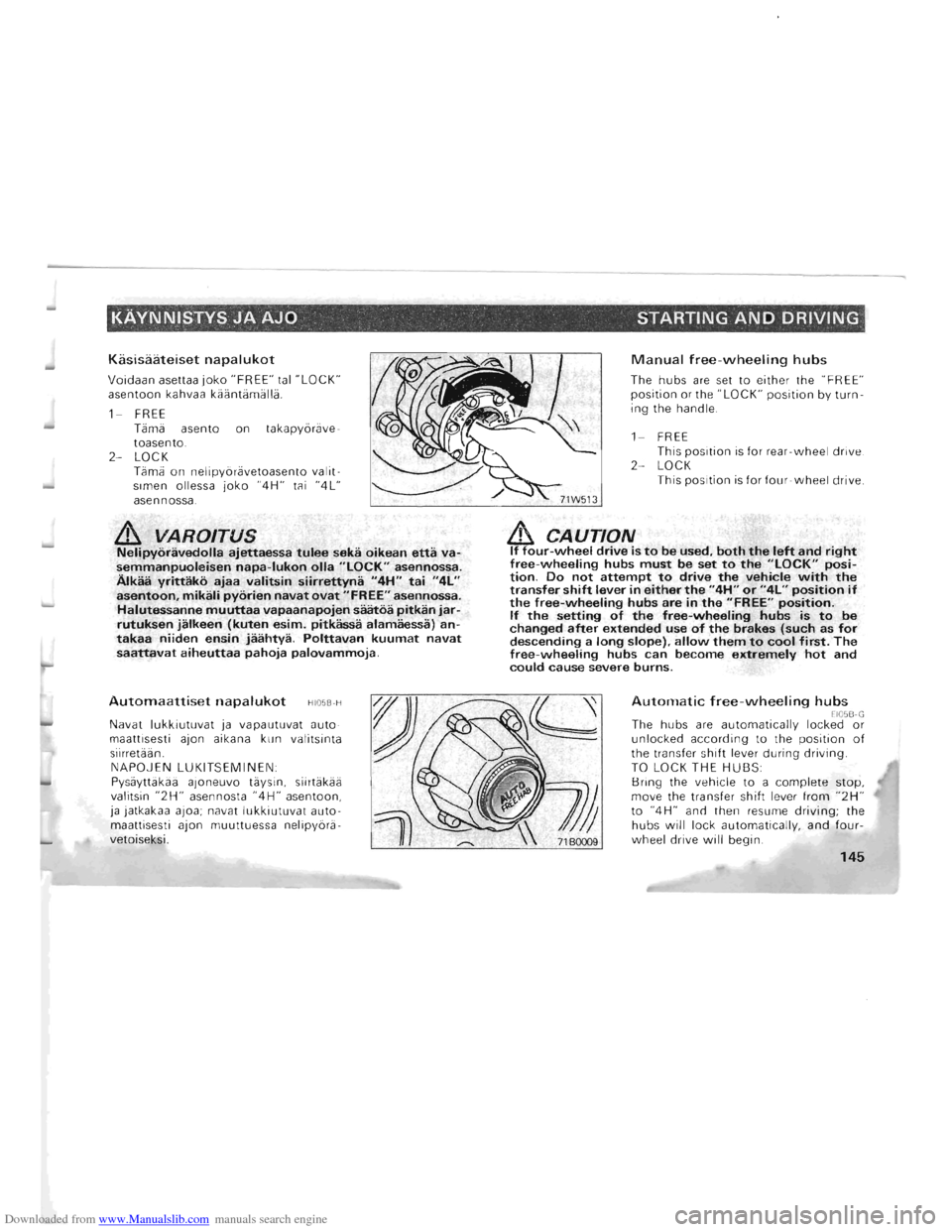
Downloaded from www.Manualslib.com manuals search engine KAvNNISTVS JA AJO STARTING AND DRIVING
Kasisaateiset napalukot
Voidaan asettaa joko "FREE" tal "LOCK" asentoon kahvaa kaantamalla.
1 -
FREE Tama asento on takapyorave
toasento .
2-LOCK
Tama on nelipyoravetoasento valit
simen ollessa joko "4H" tai "4L"
asennossa .
.&. VAROITUS Nelipyoravedolla ajettaessa tulee seka oikean etta vasemmanpuoleisen napa-Iukon olla "LOCK" asennossa.
Alkaa yrittako ajaa valitsin siirrettyna "4H" tai "4L"
asentoon, mikali pyorien navatovat "FREE" asennossa.
Halutessanne muuttaa vapaanapojen saatoa pitkan jarrutuksen jalkeen (kuten esim. pitkassa alamaessa) antakaa niiden ensin jaahtya. Polttavan kuumat navat saattavat aiheuttaa pahoja palovammoja.
Automaattiset napalukot HI05B·H
Navat lukkiutuvat ja vapautuvat auto
maattisesti ajon aikana kun valitsinta
siirretaan.
NAPOJEN LUKITSEMINEN Pysayttakaa ajoneuvo taysin. siirtakaa
valit sin "2H" asennosta "4H " asentoon,
ja jatkakaa ajoa; navat
lukkiutuvat automaattisesti ajon muuttuessa nelipyora
vetoiseksi .
Manual free-wheeling hubs
The hubs are set to either the "FREE" position or the" LOCK" position by turn
ing the handle .
1 -
FREE This position is for rear -wheel drive.
2 - LOCK
This position
is for four-wheel drive.
.&. CAUTION If four-wheel drive is to be used, both the left and right free-wheeling hubs must be set to the "LOCK" position. Do not attempt to drive the vehicle with the transfer shift lever in either the "4H" or "4L" position if the free-wheeling hubs are in the "FREE" position. If the setting of the free-wheeling hubs is to be changed after extended use of the brakes (such as for descending a long slope), allow them to cool first. The free-wheeling hubs can become extremely hot and
could cause severe burns.
Automatic free-wheeling hubs FI05B·G The hubs are automatically locked or unlocked according to the position of the transfer shift lever during driving.
TO LOCK THE HUBS: Bring the vehicle to a complete stop,
move the transfer shift lever from "2H" to "4H " and then resume driving; the
hubs will lock automatically , and four
wheel drive will begin.
145